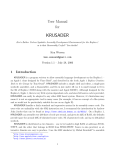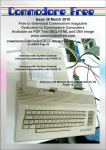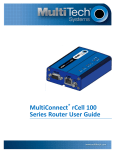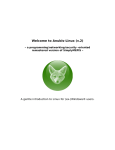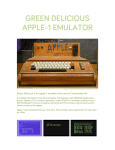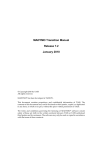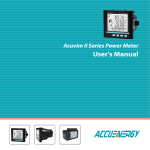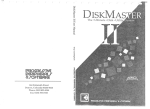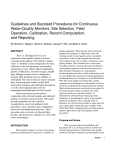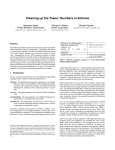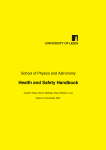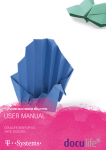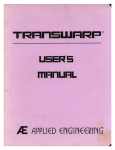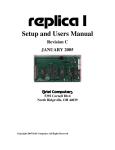Download User Manual
Transcript
User Manual for KRUSADER Ken’s Rather Useless Symbolic Assembly Development Environment for the Replica 1 or is that Reasonably Useful? You decide! Ken Wessen [email protected] Version 1.3 – December 24, 2007 1 Introduction KRUSADER is a program written to allow assembly language development on the Replica 1 – an Apple 1 clone designed by Vince Briel1 , and described in the book Apple 1 Replica Creation: Back to the Garage by Tom Owad2 . KRUSADER includes a simple shell and editor, a single-pass symbolic assembler, a disassembler, and a simple interactive debugger, and fits in just under 4K (so it is small enough to fit in the 8K of Replica 1 ROM along with the monitor and Apple BASIC). Although designed for the Replica 1/Apple 1, there is very little system dependent code, and since full source code is provided, KRUSADER can easily be adapted to any other 6502 based system. However, it’s limitations may mean it is not an appropriate tool in many cases (for example, it has no concept of a file-system and so would not be particularly suitable for use on an Apple II). KRUSADER handles a fairly standard and expressive syntax for its assembly source code. For users who are unfamiliar with the 6502 instruction set, I recommend the introduction by Andrew John Jacobs at http://www.obelisk.demon.co.uk/6502/. On a Replica 1, KRUSADER can assemble over 200 lines of code per second, and given its 32K of RAM, the defaults provide space for around 20K of tokenised source code, 7K of generated code, and up to 256 global symbols. The KRUSADER distribution is comprised of two source files, one that can assemble and disassemble 6502 code only, and the another that is able to handle the expanded 65C02 instruction set (see section 6). Both versions include a mini-monitor for interactive debugging (see section 7). In addition, two binaries of each version are supplied – one to be loaded in high RAM at addresses $7100-$7FFF, and the other that belongs in ROM from $F000-$FEFF. Since source is provided, alternative binaries are easy to produce. I use the 6502 simulator by Michal Kowalski3 to assemble 1 http://www.brielcomputers.com http://www.applefritter.com/replica 3 http://home.pacbell.net/michal k/ 2 1 the object code, and test it on the Pom1 simulator4 and my Replica 1. Although the latest version of KRUSADER supports the 65C02, it contains only 6502 code itself, and this manual will cover the 6502 features first, saving a discussion of the 65C02 enhancements until section 6. Addresses quoted in this manual will be for the high RAM version of the code, with the ROM version values following in brackets, but these values are easily offset for any particular starting address. 2 Sample Session The best way to give a quick overview of the system and its operation is to work through a couple of simple examples. First thing is to load the program, and once loaded run it by typing 7100R(F000R). At this point you will be presented with a brief message showing the version of the assembler you are running, followed by the shell prompt ? . Type N to enter a new program, and enter the code shown below. The column layout is important, with the source organised in fields. After the current line number is printed by the editor, the next 6 characters are the label field, then after a space there is the 3 character mnemonic field, then after a space a 14 character arguments field, and finally a comments field of maximum 10 characters. Hitting tab or space will automatically progress you to the next field, and to finish entering code, hit the escape key (hit return first though, or you will lose the current line). If you make an error typing a line, hitting backspace will return you to the start of the line (there is no true backspace on the Apple 1, and I have chosen not to implement the underscore-as-backspace hack used in the Apple 1 monitor and Apple 1 BASIC since it confuses the syntactically important column layout). If you only notice an error after hitting return and need to change a line, type E nnn, where nnn is the line number in question (it is not necessary to enter any leading zeroes). If you missed a line out altogether, type I nnn to insert at line nnn. ? N 000 001 LOOP 002 003 004 005 006 007<esc> LDA JSR CLC ADC CMP BNE RTS #’A’ $FFEF #$1 #’Z’+1 LOOP When you have finished entering the source, type L to list the code, and then A to assemble it. You should see the assembler output 0300-030C, indicating the target memory locations used by the assembled code. Any errors detected in the code will be displayed at this point, and can be fixed using either the I and E commands described above, or the X nnn mmm command for deleting a range of lines (the second argument mmm is optional). Once the code has been successfully assembled, run it by typing R $300. The program will run and output the string ABCDEFGHIJKLMNOPQRSTUVWXYZ 4 The original is at http://www.chez.com/apple1/Apple1project/, and a version that fixes various bugs at http://school.anhb.uwa.edu.au/personalpages/kwessen/apple1. This version also adds the capability to emulate a 65C02-based Replica 1. 2 and then return to the shell (because of the final RTS). In order to illustrate some more advanced features of the assembler, a second, more complicated example is the following. 000 ECHO 001 START 002 END 003 STEP 004 005 SETUP 006 007 008 009 00A 00B FWD 00C .LOOP 00D 00E 00F 010 011 012 013 BACK 014 .LOOP 015 016 017 018 019 01A 01B MAIN 01C 01D 01E 01F 020<esc> .= .= .= .= $FFEF ’A’ ’Z’ $30 .M LDA STA LDA RTS $280 #$1 STEP #START .M JSR CLC ADC CMP BMI RTS $300 ECHO .M JSR SEC SBC CMP BPL RTS $320 ECHO .M JSR JSR JSR RTS $340 SETUP FWD BACK STEP #END .LOOP STEP #START .LOOP Again, type L to list the code. Typing A will assemble the code – this time made up of 4 modules, each with their own starting address. The assembler will output the following upon successful assembly: ? A 0300-02FF SETUP 005 FWD 00B BACK 013 MAIN 01B ? 0280-0286 0300-030A 0320-032A 0340-0349 3 This output shows the first source line number and the memory locations used by each module in the source code (the first line can be ignored because no code is generated prior to the declaration of the SETUP module). Hitting M will show the memory taken up by the source code, in this case 2000-20E5(2300-23E5), and the value of global symbols can be queried by using the V command – e.g. typing V MAIN will get the response 0340. This is important, because it is the entry point for this program, and running it by typing either R $340 or R MAIN will result in the output: ABCDEFGHIJKLMNOPQRSTUVWXYZYXWVUTSRQPONML KJIHGFEDCBA Some other relevant features of this second example are the use of blank lines for layout, and symbols to represent both constants (e.g. START .= ’A’) and memory locations (e.g. STEP .= $30). Also note the use of the local label .LOOP in both the FWD and BACK modules. Local labels are indicated by an initial ‘.’, and have module level scope only. The .= and .M commands are two directives recognised by the assembler for defining symbols and modules respectively. It is not necessary to give a memory location argument to the .M directive, and indeed only in very special circumstances would you wish to do so. 3 Shell Commands The previous section introduced most of the available shell commands, in the context of a sample interactive session. Shell commands are entered in response to the ? prompt, and are all single key commands, with between zero and two arguments. If the shell cannot process an entered command, ERR: SYN is output to indicate a syntax error. Five of the thirteen shell commands are for source editing, and the others are for assembling, running, disassembling, querying symbols and source memory, using the monitor, and recovery. Table 1 gives a summary of all commands and their syntax. 4 Source Code As described in section 2, source code in KRUSADER requires strict adherence to a specific column-based format. The editor both assists and enforces source code entry to match this format by auto-forwarding on a space and ignoring invalid keypresses. In addition, any non-blank line must have either a valid mnemonic or directive, or start with the comment character (;). The sections below describe the source format and the legal entries for each field in detail. 4.1 Labels Labels are up to 6 alphanumeric characters in length, and may be either global or local in scope. Local labels are defined for the current module only, whereas global labels are accessible anywhere in the program. Up to 256 global labels may be defined, and up to 32 local labels in any one module. Local labels are any labels that begin with a . (i.e. a period). Labels may be used prior to being defined, i.e. as forward references, and up to 85 forward references are allowed. However, forward references are more limited than normal labels since they are always treated as words (i.e. 2 bytes in size), and any expression involving them must also result in a 2 byte value. In particular this means forward references cannot be used with the < and > operators (see section 4.5). 4 Command N Arguments I <nnn> L <nnn> X nnn <mmm> E nnn M A V R LABEL $nnnn or LABEL D <$nnnn or LABEL> ! $ P <c> Action Start a new program. This command will clear any existing source, and prompt for source entry from line 000. Insert code from line nnn, or at the end if no argument. If k lines are inserted, existing lines from nnn are shifted down by k. List the source starting from line nnn, or the beginning if no argument. Press any key to stop the listing. Delete from lines nnn to mmm inclusive. If just one argument, delete line nnn only. Care must be taken since this will change the line number associated with all subsequent source lines. Delete cannot be undone. Edit line nnn, and insert after. This is equivalent to typing X nnn followed by I nnn, so the existing line is deleted immediately, and as for the X command, it cannot be recovered. Show the memory range used to store the current source code. Assemble the current source code. Show the value of the given label or expression. Run from address $nnnn. If the program ends with an RTS, control is returned to the shell. Otherwise, re-enter the shell at address $711C($F01C). Disassemble from address $nnnn, or continue from the last address if no argument. Press any key to stop the disassembly. Send the next line typed as a command to the Apple 1 Monitor. Drop into the Apple 1 Monitor. You can re-enter the shell at address $711C($F01C). Panic! This command attempts to recover lost source (usually due to zero page data corruption). If the first line of source starts with a label, then give the first letter of that label as an argument to this command. For more detail, see the section on source tokenisation 8.2 Table 1: KRUSADER shell commands. Note that any shell commands that use labels are dependent on the assembler’s global symbol table being intact, specifically the pointer information in zero page locations $E9, $EA and $EB, and the table data itself (see figure 1). Optional arguments are indicated by < · · · >. 5 Once any particular module has been assembled, all local labels are cleared and an error is reported if any forward references involving local labels remain unresolved. However, any forward references to global labels that remain unresolved are simply held, and will only cause an error if they are still unresolved once assembly of the entire program has been completed. KRUSADER will report an error if a global label is redefined, or a local label is redefined within a module. 4.2 Mnemonics KRUSADER recognises the standard 3 character mnemonics for all legal 6502 instructions. These are shown in table 2. Undocumented opcodes are not supported, and the 65C02 support is discussed in section 6. The editor will not accept any line with an invalid entry in the mnemonic field. Note that when the 6502 executes a BRK instruction, the return address pushed onto the stack is PC+2, and so KRUSADER assembles the BRK opcode as two $00 bytes and an RTI will return to the next instruction. However, the disassembler will show these as consecutive BRK instructions. Operation Load/Store Transfer Stack Logical Arithmetic Increment/Decrement Shift Jump/Call Branch Status Flag Other Mnemonics LDA, LDX, LDY, TAX, TXA, TAY, PHA, PLA, PHP, AND, EOR, ORA, ADC, SBC, CMP, INC, INX, INY, ASL, LSR, ROL, JMP, JSR, RTS BCC, BCS, BEQ, CLC, CLD, CLI, BRK, NOP, RTI STA, TYA, PLP BIT CPX, DEC, ROR STX, STY TSX, TXS CPY DEX, DEY BNE, BMI, BPL, BVC, BVS CLV, SEC, SED, SEI Table 2: Recognised mnenomics. 4.3 Arguments Table 3 shows the argument format for each of the 6502’s addressing modes. In addition, $nnnn can always be replaced by a label or expression, and similarly $nn so long as the result is a single byte. (Expressions are introduced in section 4.5 below.) A single byte may also be represented using ‘c’ for a given printable character when immediate mode is being used. Whenever a word sized argument actually has a high byte of zero and the corresponding byte size addressing mode is legal, the byte size mode will be used. In addition, some mnemonics support the absolute,Y addressing mode but not the zero page,Y mode. In these cases, a byte sized argument will be increased to word size in order to make the instruction legal. Constants are always hexadecimal. 6 Addressing Mode Implicit Accumulator Immediate Zero Page Zero Page,X Zero Page,Y Relative Format Addressing Mode Absolute Absolute,X Absolute,Y Indirect Indexed Indirect Indirect Indexed #$nn or #’c’ $nn $nn,X $nn,Y *+/-nn Format $nnnn $nnnn,X $nnnn,Y ($nnnn) ($nn,X) ($nn),Y Table 3: Source code syntax for the 13 addressing modes of the 6502. 4.4 Comments There are two ways to include comments in KRUSADER source. Full line comments may be entered by typing a ‘;’ character as the first character in the line, followed by a space5 . Then all line space from the mnemonic field onwards can be used for comment text. Alternatively, the remainder of any line after the end of the argument field is also reserved for comments, and in this case, no special character is required to preceed their entry. Comment entry is the only place where spaces are treated literally, and examples of both kinds of comments are shown in the code snippet below: 003 ; 004 005 4.5 HERE IS A LONG COMMENT CMP #’Z’+1 HERE ARE BNE LOOP SHORT ONES Expressions KRUSADER allows the use of 4 operators in a mnemonic’s argument: +, -, < and > for plus, minus, low byte and high byte respectively. The plus and minus operators take a constant signed byte argument only, and unlike other places where constants are employed, the argument requires no preceeding $. The high and low byte operators are used to extract the relevant single byte from a word sized constant or label, and have lower precedence than + and -, and so are applied last of all when evaluating the expression. For example, if we define the symbols BYTE .= $12 and WORD .= $3456, then the following expressions are evaluated as listed below: • • • • • BYTE+1 BYTE+80 <BYTE+80 WORD+1 WORD-1 = = = = = • • • • • $13, $FF92, $92, $3457, $3455, WORD+FF >WORD <WORD >WORD+10 <WORD+10 = = = = = $3455, $34, $56, $34, $66. As described in section 4.1, forward references can be used in expressions involving the + and - operators, but not in expressions involving the < and > operators. 5 Strictly speaking the space is not required, but if it is absent, the source formatting will be upset. 7 4.6 Directives In addition to the 6502 mnemonics described in section 4.2, KRUSADER supports a number of directives for managing symbolic constants, program structure and data. Directives are entered in the mnemonic field, and always consist of a period followed by a single letter. Each of the available directives is described in table 4 below. Directive LABEL .= $nnnn LABEL .M <$nnnn> <LABEL> .B $nn <LABEL> .W $nnnn <LABEL> .S ’cc. . .c’ Action Define a named constant. The label must be global in scope, and redefinitions are ignored without error. Expressions or a quoted character are allowed. Define a new module, optionally at the specified address, or else just continuing on from the previous module. The label must be global in scope, and redefinitions are ignored without error. Expressions are not allowed. Store the byte-sized value $nn at the current PC. Expressions or a quoted character are allowed, but not forward references. Store the word-sized value $nnnn at the current PC in little-endian byte order. Expressions are allowed, but not forward references. Store the string literal at the current PC. The string must be 13 characters or less, and may not containt spaces. Table 4: Directives supported by KRUSADER. Optional fields are indicated by < · · · >. 5 Errors Error reporting in KRUSADER is necessarily limited by its size constraints, but nevertheless it attempts to capture as many errors and ambiguities as possible, and report them in a meaningful way. Errors can arise in response to a shell command or as a result of an assembly. When appropriate, the offending line or symbol will be displayed. Error ERR: SYN ERR: MNE ERR: ADD ERR: SYM ERR: OVF Meaning Syntax error in either a shell command or a source code line. An illegal mnemonic code was encountered. An illegal addressing mode was encountered. A needed symbol was not found. Too many symbols has lead to a symbol table overflow. Table 5: KRUSADER error messages. 8 There are many reasons why an “ERR: ADD” may occur, especially if the offending line involves symbols. For this reason it can be helpful to query the symbols involved using the V command (see table 1). If the symbol is indeed the cause of the addressing mode error, the V command will report a more useful error, specifically “ERR: SYM” if the symbol is undefined, or “ERR: OVF” if the symbol tables are full. 6 65C02 Support With version 1.2 of KRUSADER, optional support for the 65C02 processor has been included. The 65C02 is an enhanced version of the basic 6502 chip, offerring some extra operations and addressing modes, and fixing a few problems with the original design Although these enhancements are all useful, essentially the changes are a case of “too little, too late” and frequently programmers choose to stick to pure 6502 code for portability reasons. In addition, 65C02s from various manufacturers have slightly different command sets, thus adding to the confusion. However, since the 65C02 is the CPU in nearly all Replica 1 computers, it makes good sense for KRUSADER to support this chip, and this section describes this support. Nevertheless, no 65C02 specific operations are used in the KRUSADER code itself. 6.1 Additional Mnemonics The ten 65C02 instructions supported by KRUSADER are listed in table 6. Each of these is valid on all versions of the 65C02, and also on the 65C816. No other instructions are supported – specifically the single bit instructions BBR, BBS, RMB, SMB found on the Rockwell and WDC versions of the 65C02, and the STP and WAI instructions found on the Rockwell 65C02 only are not recognised. Operation Load/Store Stack Logical Increment/Decrement Branch Mnemonics STZ PHX, PLX, PHY, PLY TSB, TRB INA, DEA BRA Table 6: Additional mnenomics supported by the 65C02 version of KRUSADER. 6.2 Additional Addressing Modes The 65C02 introduced two new addressing modes – zero page indirect and absolute indexed indirect. The KRUSADER source code syntax for these modes is shown below: • Zero Page Indirect – ($nn) • Absolute Indexed Indirect – ($nnnn,X) 9 7 The Mini-Monitor The 8K of Replica 1 ROM, with Integer BASIC, the Monitor, and KRUSADER, leaves just enough space for a simple interactive debugger, and this section describes the debugger included with the ROM version of KRUSADER. By making the IRQBRK vector at $FFFE,F point to the DEBUG routine at address $FE19 ($FE0A for the 65C02 version), execution of a BRK passes control to the mini-monitor, and the registers and next instruction are displayed as follows: A-41 X-FF Y-07 S-FD P-23 CZ 0306 20 EF FF JSR $FFEF The P register is shown both as a value, and as a string from “NVBDIZC” indicating which flags are set. (In the above example, the zero flag (Z) and the carry flag (C) are set.) The - prompt indicates that the mini-monitor is waiting for a command. Valid commands are shown in table 7, and are used to change the register values, set the next instruction location, or drop into the Apple 1 monitor. Command Ann Xnn Ynn Snn Pnn Lnn Hnn R $ ! T Action Put the value $nn into the A register. Put the value $nn into the X register. Put the value $nn into the Y register. Put the value $nn into the S register. Put the value $nn into the P register. Set the low byte of the PC for the next instruction to be executed to the value $nn. Set the high byte of the PC for the next instruction to be executed to the value $nn. Resume execution at the currently displayed instruction. Enter the Apple 1 monitor. Enter an Apple 1 monitor command. Trace execution step by step (6502 version only). Table 7: Mini-monitor commands. To return to the mini-monitor from the Apple 1 monitor, type FE23R (or FE0AR if you are running the 65C02 version). Another useful address to remember is the disassembly routine at $FAD0 ($FAF8 for the 65C02 version), but bear in mind that using this routine involves changing the stored PC value at locations $F5 and $F6, and this must be restored, using either the monitor or the mini-monitor, if you wish to resume the program being monitored. 7.1 Sample Mini-Monitor Session This section gives a short example of a mini-monitor session. In order to work through this example, first start the assembler, and enter the following short program that includes a BRK instruction. 10 F000R F000: A9 KRUSADER 6502 BY KEN WESSEN ? N 000 LDA #’A’ 001 JSR $FFEF 002 SEC 003 BRK 004 JSR $FFEF 005 RTS 006 ? Assemble it and examine the resulting code. ? A 0300-030B ? D $300 0300 A9 41 0302 20 EF FF 0305 38 0306 00 0307 00 0308 20 EF FF 030B 60 ... LDA JSR SEC BRK BRK JSR RTS #$41 $FFEF $FFEF When this program is run, it should print A, set the carry flag (C), and then drop into the minimonitor. ? R $300 A A-41 X-FF Y-07 S-FD P-21 BC 0308 20 EF FF JSR $FFEF Use the A command to change the value in register A from 41 to 42, confirm the change by checking the new register display, and then resume the program with the R command. The program will then print a B, corresponding to the new value in register A, and return to the assembler shell as normal. -A42 A-42 X-FF Y-07 S-FD P-21 BC 0308 20 EF FF JSR $FFEF -R B ? Now let’s enter a new program, this time involving a subroutine call. 11 ? N 000 001 002 003 004 005 SUB 006 007 008 009 ? LDA #’A’ JSR SUB JSR $FFEF RTS .M BRK LDA #’Z’ RTS Assemble it, examine the resulting code, and run. It will break into the mini-monitor on entry to the subroutine SUB. ? A 0300 SUB 005 0309-030C ? D $300 0300 A9 41 LDA 0302 20 09 03 JSR 0305 20 EF FF JSR 0308 60 RTS 0309 00 BRK 030A 00 BRK 030B A9 5A LDA 030D 60 RTS ... ? R $300 #$41 $0309 $FFEF #$5A A-41 X-FF Y-07 S-FB P-24 B 030B A9 5A LDA #$5A When in the mini-monitor, unroll the stack by adjusting the value in S, and set the PC to $0305. -SFD A-41 X-FF Y-07 S-FD P-20 030B A9 5A LDA -L05 A-41 X-FF Y-07 S-FD P-20 0305 20 EF FF JSR - B #$5A B $FFEF Now resume, and A will be printed rather than Z since lines 007 and 008 were never executed. Since we also adjusted the stack pointer, the RTS on line 003 will return control to the assembler. -R A ? 12 7.2 Tracing Assembled Code The 6502 version of KRUSADER left just enough space free in the Replica 1 ROM for implementing a single step trace function in the mini-monitor. In the absence of size constraints, this function can be added to the 65C02 version as well, but it would need a little bit of extra code to properly handle the BRA instruction and the absolute indirect addressing mode. To see how the trace function operates, enter the following short program: ? N 000 001 002 003 004 005 006 007 ? BRK PHP SEC LDX #$0 DEX PLP RTS Assemble and run, and it will drop into the monitor right away. ? A 0300-0308 ? R $300 A-0D X-01 Y-07 S-FD P-30 B 0302 08 PHP Now we can use the T command to step through the code. After one step, the current value of the status register (P = 30) will be pushed onto the stack, and the stack pointer will decrease by 1. -T A-0D X-01 Y-07 S-FC P-30 B 0303 38 SEC As we step through, we can watch the changes in the status flags in response to the execution of each command. Follow the below to see the carry, zero and negative flags being set. -T A-0D X-01 Y-07 S-FC P-31 0304 A2 00 LDX -T A-00 X-01 Y-07 S-FC P-33 0306 CA DEX -T A-FF X-01 Y-07 S-FC P-B1 0307 28 PLP - BC #$00 BZC NBC 13 After one last step, the status register will be restored to its earlier value, so the flags will return to off, and the stack pointer increased by 1. Then, as usual, the R command will continue execution of the program, and so the RTS command will return control to the assembler shell. -T A-FF X-01 Y-07 S-FD P-30 B 0309 60 RTS -R ? 7.3 Using the Apple 1 monitor The minimonitor includes no commands for examining or altering memory. Rather, this functionality is provided via the standard Apple 1 monitor by using the ! command to submit instructions to the monitor as shown in the following example. A-D2 X-00 Y-01 S-FD P-33 BZC 0002 00 BRK -! 1000.101F 1000: 00 00 00 1008: 00 00 00 1010: 00 00 00 1018: 00 00 00 A-D2 X-00 Y-01 0002 00 -! 1000:1 2 3 4 00 00 00 00 00 00 00 00 00 00 00 00 00 00 00 00 00 00 00 00 S-FD P-33 BZC BRK 1000: 00 A-D2 X-00 Y-01 S-FD P-33 BZC 0002 00 BRK -! 1000.1007 1000: 01 02 03 04 00 00 00 00 A-D2 X-00 Y-01 S-FD P-33 BZC 0002 00 BRK - 14 8 Low Level Information This section presents some low-level information about how KRUSADER works, and is not required for normal use of the assembler. However, there are many situations where this information is quite important for managing source and machine code, and correcting errors. The most important memory locations are shown in table 8, and discussed in the following sections. Address $7100($F000) $711C($F01C) Function Assembler entry Assembler re-entry (shell) $7304($F204) Move memory (non-overlapping) $FE14∗ $FE1E∗ Mini-monitor entry Mini-monitor re-entry (ROM version only) $7BCA($FACA)∗ Disassembler Zero Page Dependencies $F8 – High byte of assembled code storage area $F9 – High byte of local/global table boundary $FE,$FF – Address of source code storage area $E9,$EA – Global symbol table address $EB – Number of global symbols $50,$51 – Source location $52,$53 – Destination $54,$55 – Bytes to move $F0-$F4 – Register storage (S,P,Y,X and A) $F5,$F6 – Address of next instruction $0F-$11 – Input buffer $E0-$E8 – Code buffer for trace function $F5,$F6 – Address to disassemble from Table 8: Important function entry points and related memory locations. ∗ The minimonitor addresses are $FE03 and $FE16 in the 65C02 version, and the disassembler address is $FAEA. 8.1 Memory Map Proper operation of the assembler requires a number of things to reside in the machine’s memory. There is the assembler code itself, the program source code, the assembled code, and various symbol tables. The default arrangement for both the high RAM and the ROM versions of KRUSADER are shown in figure 1. The local symbol and forward reference tables take up a fixed 1K of space, with 256 bytes taken up by the locals, and the remainder for the forward references. The global symbol table grows downward to a maximum of 2K (corresponding to 256 symbols). The two most important source locations have both been mentioned already, and are $7100($F000) for initial program entry, and $711C($F01C) for returning to the shell. KRUSADER also uses a number of zero page locations, but mostly as an input buffer and during assembly. The only locations that absolutely must be maintained are $F8, $F9, $FE and $FF. These hold the high byte of the default assembled code storage location, the high byte of the local/global symbol table boundary, and the low and high bytes of the source code storage location respectively (See figure 1 for the appropriate values). Additionally, locations $E9, $EA and $EB are needed if the shell is to have access to the global symbol table for various commands (see table 1), and locations $0F, $10, $11, $E0 to $E8, and $F0 to $F6 are used by the mini-monitor. If you wish to use all the features of KRUSADER while developing assembly language programs, it is wise to avoid using these locations in your programs. Replica 1 users need to beware of Apple 1 BASIC 15 High RAM Version ROM Version 7FFF FEFF KRUSADER code 7100 70FF 6E00 6D00 Forward References Local Symbols F000 7FFF 7D00 7C00 Global Symbols 6500 7400 Program Source 1D00 2000 Program Target 0300 0100 0000 Zero Page 0300 0100 0000 Figure 1: Memory map for both the high RAM and the ROM versions of KRUSADER. Note that the global symbol table starts at the local/global table boundary and grows downwards, whereas the program source starts at the low address and grows upwards. As mentioned in section 8.1, the important values are the high byte of the target memory, the high byte of the local/global symbol table boundary, and the start of the source code storage. For the RAM version, the values are $03, $6D, $00 and $1D, and for the ROM version they are $03, $7C, $00 and $20. After initialisation, these values are stored in zero page locations $F8, $F9, $FE and $FF. because it may overwrite several of these values, so they need to be restored before returning to the KRUSADER shell6 . 8.1.1 Changing Default Memory Locations For the RAM based version of KRUSADER, the default values can be altered by changing the values at memory locations $7101, $7105 and $7109 in the assembler code. For the ROM based version, the default values can only be altered after the program has been run, and the alternative values must be entered directly into the zero page locations mentioned above, before resuming KRUSADER at location $F01C7 . 6 7 The P command is useful for restoring the default values to these zero page memory locations. The P command will overwrite any values entered in this way. 16 8.2 Source Tokenisation Scheme Any entered source is stored in a tokenised form in order to save space. The tokenisation employed is quite simple because there was even less space available in the code to implement it! Three special codes are employed – $01 as a field terminator, $00 as a line terminator, and $02 00 to indicate a blank line. Labels, arguments and comments are stored as entered with the field terminator marking their end, and mnemonics and directives are encoded as a single byte. Program end is indicated by a line starting with $00. This simple scheme results in a reduction of the source code size by a factor of 2 to 3. Also provided in the KRUSADER distribution is C source code for a program that can convert more general source code formats to the required tokenised form, so that they may be uploaded to the assembler. However, this simple program does not translate different formats for directives or addressing mode specification, so if any such changes are required, they must be done manually. Once you have the converted source data, simply launch KRUSADER as normal, enter the monitor and load in the tokenised data to the source storage memory, and resume. The source will then be available to KRUSADER as if you had typed it in as normal. However, syntax and formatting errors in the source may not be well handled since the error handling is designed around the restrictions placed on source input in the usual manner. Unfortunately the binary source tokenisation is incompatible between the 6502 and 65C02 versions of the assembler due to differences in the mnemonic indices and directive encoding. The ‘-C’ command line option may be used with the tokeniser program to specify the 65C02 version binary format. One useful thing to keep in mind is the N command simply clears the source program from memory by putting a $00 as the very first byte of the source storage location. So if N is typed accidentally, the source can be easily restored. To do this manually, simply enter the monitor using $, and change this initial byte to either $01 if there was no label, or the first byte of the label, and then resume KRUSADER as normal with 711CR(F01CR). This process is automated by the P command. You should note however that there is no way to recover source lines deleted with the X or E commands since the memory is immediately overwritten. 8.3 Moving Memory If you want to copy a block of memory to another location (if you are backing up source or machine code via the expansion interface for example), you can make use of one of the memory moving subroutines inside the assembler as follows. First work out non-overlapping source and destination addresses – call these srcL, srcH, destL and destH, and then the size of memory to move – sizeL and sizeH. (You can do this using the M command for source or watching the output of the A command for assembled code.) Then drop into the monitor using the $ command, and enter: 50: srcL srcH destL destH sizeL sizeH to set the parameters, and 7304R (F204R) to do the move. 8.4 Testing KRUSADER comes with a number of sample programs, both in binary and hex dump formats, and these are useful for verifying its correct operation. The most important sample in this regard is TestSuite.asm, which contains a number of modules for testing the assembler. (For the 65C02 version, there is the pair of source files: TestSuiteC.asm for the pure 6502 tests, and TestSuite65C02.asm for tests of the 65C02 extensions.) The first test of course is that the source 17 assembles without error, then R MAIN will cause the program to verify its own assembled code and report any errors. This test suite covers all the 6502 instructions, using all their addressing modes and various formats for arguments where relevant, as well as each of the available directives. In addition, both forward referencing and the various kinds of expressions supported by KRUSADER are tested – both alone and in combination with various addressing modes. A successful run of this suite of tests is a very good indication that KRUSADER is functioning properly. Because of the size of the test suite code, it can not be run with the RAM version of KRUSADER without changing the start address for program source storage as described in section 8.1.1 above in order to allow enough room for the source code, the assembled code, and the global symbol table. Specifically, prior to running KRUSADER, the value at address $7101 needs to be changed to $14, or if KRUSADER is already running, this value of $14 can be loaded directly into the zero page address $FF. 18 9 Release History • KRUSADER 1.0 (May 2006) – First version released. – Target CPU is 6502 only. • KRUSADER 1.1 (July 2006) – Fully tested version - several bug fixes over version 1.0. – Comes with code for a thorough automated testing of itself. – Various enhancements over version 1, most notably: ∗ ∗ ∗ ∗ Forward references can cross module boundaries. Symbol redefinition is reported as an error. Comment only lines. Approximately 20% faster assembly. – This version was added to the Replica 1 SE ROM. • KRUSADER 1.2 (August 2006) – Fixes an obscure bug in version 1.1 that prevented assembly of JMP or JSR commands targetting page zero. – Improved syntax checking. – More compact implementation saves more than 200 bytes over version 1.1. – Extra space used to implement a mini-monitor for interactive debugging. – Also available is KRUSADER 65C02, a version that supports 65C02 commands in both the assembler and disassembler. – Still fits inside the 3840 free bytes of the Replica 1 ROM! • KRUSADER 1.3 (December 2007) – Made source and disassembly listings continuous until key pressed. – Added ‘!’ command to the shell and minimonitor. – Bundled with the Krusader Toolkit 8 – an integrated editor, terminal and emulator for the Replica 1. 8 http://school.anhb.uwa.edu.au/personalpages/kwessen/apple1/ktk.zip 19



















